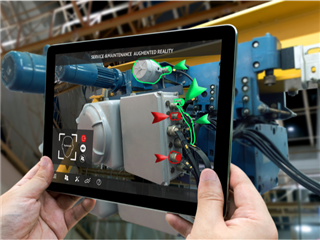
PHOTO:
Shutterstock
Today, consumers are more inclined to support brands that are aligned with their core values, according to recent data from 5WPR. Traditional marketing and advertising is rapidly losing ground to the level of personalization and immersiveness virtual and augmented reality put on the table.
For tech companies looking to innovate, virtual reality and augmented reality represent a new territory with still uncharted possibilities. With virtual reality, tech companies can build a new world and bring it to the consumer. With augmented reality, they can enhance what is already in our world and add a new layer of interactivity and experiences. That’s why early adopters and innovators are looking at AR/VR as a way of engaging with their potential customers.
A quick search using Google Trends reveals that the interest about VR has spiked in the past five years and indicates that we’re now living the popularization and consolidation of VR and that only indicates that virtual reality is more than a fad. Through AR and VR, tech companies can create new experiences that are seamlessly integrated through the platforms where users spend most of their time. However, while AR and VR are often bundled into the same category, they offer different benefits for companies. “AR and VR need to be looked at as separate entities. VR offers a much more individualized experience that benefits a limited number of people at a time. At the same time, AR is a more social experience that can reach groups of people simultaneously,” said Liat Sade-Strenberg, CEO at CA-based Fuse.it.
For tech companies, both types of experiences represent a treasure trove of data that can be ethically collected and analyzed to deliver even better experiences in the future or target users with personalized ads following their preferences.
Related Article: Why AR and VR Usage Is Expected to Grow in 2020
Is VR/AR the Future of Marketing for Tech Brands?
While there are different opinions on the subject, the majority of marketers and developers see virtual and augmented reality as great tools to deliver value to their customers. For instance, Casie Millhouse, Chapter President of the AR/VR Association, Singapore, says that “VR provides an opportunity to embed point of sale communications within a simulated and immersive real-life retail experience.” For tech brands, this could go from giving users the chance of testing new products in virtual reality to adding a new level of interactivity to software, all in their own homes, using their own devices.
Nevertheless, not everything that glitters is gold. There are still some hurdles to overcome for VR and AR to be the future. The issue with VR is access. “To successfully create this experience, consumers will need to have the proper hardware available. But, unlike VR, AR can be implemented on any device, creating more accessible avenues of access for consumers. Both implications cannot be overlooked for tech companies looking to utilize mixed reality technology,” says Sade-Strenberg. The need for proper hardware to enjoy virtual reality is still a situation that brands of all shapes and sizes need to circumvent, but with the shareability of AR experiences brands could still reap some benefits from the added interactivity.
How to Leverage VR and AR
While for tech brands the benefits might not be as obvious as it could be for Warby Parker, and its AR-powered app that enables users to try on new glasses, the benefits are still here, especially when it comes to improving buyer awareness, accelerating the purchasing process, and personalizing offers. In fact, according to the Digital Marketing Institute, 75% of the brands have already thought of creating a VR/AR strategy, which suggests a trend for AR/VR-powered marketing.
Millhouse considers that “many people think VR/AR is the end all and be all of a marketing campaign. I believe it is only one piece of a puzzle. You need one clear success metric or ‘North Star’ to guide you. Once you have that, look at the different touchpoints of your audience, your customers or your potential customers.” That being said, Millhouse gave us some primordial questions tech companies need to ask themselves before attempting to leverage VR/AR technology.
Ask yourself:
- What kind of team do we need to do this?
- What is the tech stack needed to get this done?
- What part of our operations would VR/AR enhance?
- How can we do a small scale test before we build it out completely?
Once you’ve done that, keep in mind that integrating VR/AR to your marketing strategy depends on your brand. However, if you’re looking to make a lasting impact on your prospects and customers, AR and VR can be a nice thing to try to really make a statement and get known.
In a world where customers are jaded by the traditional Facebook ads and outdated TV spots, virtual and augmented reality can be just the tool that cuts through the noise and brings tangible benefits for the company.